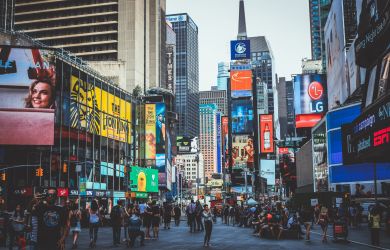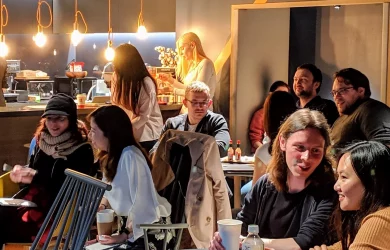
August 31, 2006
Kawasaki Daishi
Kanto’s most impressive temple is closer than you think
By Metropolis
Originally published on metropolis.co.jp on August 2006

Photos by Reg Dunlap
Lined with trinket shops and display cases full of faded plastic food, the streets that lead to Kawasaki Daishi hardly promise an enlightening experience. The area resembles many long-in-the-tooth Tokyo suburbs, where merchants ply their trade out of shabby storefronts that, like the proprietors, have seen better days. Although I glimpse tantalizing signs that something out of the ordinary lurks nearby—a colorful burst of daruma dolls, a sign on a side street that reads “Senbei Factory,” ornate woodwork carved into a massive fence running along the road—the area has the underwhelming feel of a washed out mill town.
Moments later, as I pass through the massive outer gate of Kawasaki Daishi Heikenji Temple, what surprises me most is not that I’ve been swallowed up in another world—a world of incense, contemplation and the 1,400-year history of the Buddhist Shingon sect—but that I remain rooted in the one I’ve just left. Low-key visitors exploring the grounds appear as if they’ve wandered over from nearby streets. Families stroll and children play in quiet groups. Stalls selling yakisoba and gyu-suji, the quintessential Japanese street food, abound. I’m hard-pressed to feel a sense of wonder—until the brightly robed monks and the stunning architecture begin to instill in me a sense of their timeless grandeur.
As one of the principal sites of Shingon Buddhist worship, Kawasaki Daishi holds great significance for area residents—as demonstrated by the tens of thousands of celebrants who arrive for the hatsumode New Year visits. Yet the lifeblood of the temple is in its everyday role as a promulgator of Buddhist thought and culture. Most prominent among these is the daily Goma purification rite, where Japanese come for blessings to fortify them during their yakudoshi, or “climactic” years—ages 19 and 33 for women, 25 and 42 for men.

Kawasaki Daishi’s neighborhood may be drab, but approaching the temple is not without its charms. The shopping street that fronts the main gate is notable for offering every imaginable variety of senbei rice crackers, the area’s signature product, with dozens of stalls crammed full of the salty treats. The rat-a-tat-tat of flat-handled knives crushing rice into paste permeates the air, as do the cries of dozens of barkers pushing their wares.
The outbuildings that dot the temple’s sprawling grounds will be familiar to anyone who’s visited the Kamakura area. The most brilliant, perhaps, is the Hakkaku Gojunoto, a five-storied pagoda that towers above the smaller-scale shrines, gardens and statuary. Nearby, the lovely gilt eaves and verdigris roof of Fudomyoo Hall are bordered by ornate stone lanterns and an incense-burning cauldron. A crane pool, sedate statues of Buddha and, incongruously, a building called the Prayer Hall for Safe Driving provide visitors with a couple good hours of exploration.
The centerpiece of the grounds, both physically and spiritually, is the massive Dai Hondo main hall, where participants are welcomed for the yakudoshi ritual and where visitors can glimpse the proceedings from atop the broad wooden stairs. Dai Hondo, like virtually all of Kawasaki Daishi, is actually a reproduction of the original 12th-century structure that was decimated in World War II. Nowadays, they only hint at the venerable history upon which the temple is founded.

Kawasaki Daishi is dedicated to the teachings of the priest Kukai (774-835), known posthumously as Kobo Daishi and sometimes called “the father of Japanese Buddhism.” According to legend (dutifully reproduced in the visitor center’s promotional literature), the temple was established by a disgraced samurai-turned-fisherman named Hirama Kanenori. After a prophetic dream, Kanenori discovered a wooden statue of Kobo Daishi in the sea, and along with a wandering priest named Sonken, he built the temple grounds to house the figure. To this day, an image of Kobo Daishi is displayed every ten years in a gaicho ceremony, which is when temples traditionally exhibit their artwork.
A cultural clearinghouse, Kawasaki Daishi is also committed to the diffusion of Buddhist learning; it hosts a Sunday school for children as well as classes in ikebana, tea ceremony and goeika (Buddhist hymns). Noh festivals and nature ceremonies abound throughout the year, including equinox celebrations in spring and autumn. But the temple’s ties to the community, as a site of worship and a place to receive blessings, are what give Kawasaki Daishi its splendor and ensure its continued relevance.
Kawasaki Daishi station is a 30min train ride from Shinagawa stn. Take the Keikyu line to Keikyu Kawasaki stn and transfer to the Keikyu Daishi line. A one-way ticket is ¥230. The temple grounds are located about a 15min walk away. In addition to the street food on the temple grounds, traditional eateries line the route from the station; be sure to leave room for the many varieties of senbei on sale everywhere. Upcoming events include the Autumn Grand Festival on Sep 20-21, Autumnal Equinox Week Sep 20-26, and the traditional “Autumn Visit” on Oct 1, 15 and 20-21. The area is also known for the Kanamara fertility festival each April.
[geo_mashup_map]

-390x250.jpg)





